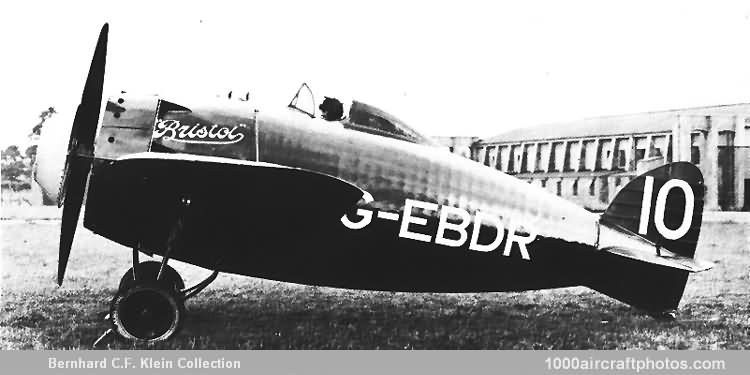05/31/2011. Remarks by Johan Visschedijk: "Chief Designer of the Bristol Aeroplane Company Limited, Wilfrid T. Reid, presented the first sketch of the Racer on November 7, 1921, and the prototype was ordered on January 23, 1922. The power plant, a 480 hp Bristol Jupiter nine-cylinder air-cooled radial engine, was recessed in the front of the forward circular streamline main frame and surrounded by a three-ply outer cowl, within which was the complex array of inter-cylinder baffles and cooling-air ducts for the cylinders. The pilot's cockpit was just aft of the rear frame.
The Racer had fabric covered untapered wings with full-span ailerons, two spars of a special laminated steel and wood construction, and no external bracing. They were bolted into root-stubs forming part of the two fuselage main ring frames, between which the fuel tank was installed. The rear fuselage was a true monocoque structure made from three layers of tulip-wood veneer laid diagonally over light circular hoops braced internally by radial steel spokes. The cantilever tail unit was attached by a horizontal hinge about which it could be rotated by a screw-jack for adjustment of tail plane incidence during flight.
The most striking feature of all was the landing gear, which the pilot could retract by means of a chain and sprocket gear. Retracted, the wheels lay flush within the lower surface of the wing and the curved chassis tubes were concealed in grooves in the fuselage. The propeller carried a large-diameter spinner made of three layers of tulip-wood, as in the rear fuselage, and similarly braced by cycle-spokes. The aircraft was finished in red and the registration G-EBDR, issued on June 27, 1922, was painted on in white.
The first flight was made in early July, 1922 by Chief Test Pilot Cyril F. Uwins, after he had hardly left the ground when he found that the full-span ailerons were far too powerful and caused violent wing torsion and lateral instability. He managed to complete a wide circuit, and made a safe landing. The second flight was made after the wing had been braced by external streamline wires, immediately after take off the spinner burst and shattered the fabric of the left wing and knocked off the pitot head. In the third flight, without a spinner, the high drag of the open engine severely limited the speed, but the large ailerons still gave serious over-control.
The fourth flight was made with a rollers and cam device designed to produce small aileron movements for small movements of the stick but progressively larger movements as the angle of displacement of the stick increased. This produced the desired aileron behavior on the ground, but immediately the machine became airborne the up-load on the ailerons pulled the rollers out of contact with the face of the cam so that virtually there was no lateral control whatsoever; once again Uwins made a precarious circuit and a safe landing.
Direct control was restored and the ailerons were reduced to some 40% of their original area. A smaller spinner on a hub ahead of the airscrew was made, acting as a fairing and 'idler' and was intended not to rotate in flight. Three more flights were made and suitably angled vanes were fitted to the surface of the spinner to achieve this, but although the spinner gave no more trouble, it provided a quite inadequate fairing for the front of the aircraft.
Seven flights in all were made, but since it had no prospect of winning a major race while the spinner trouble persisted, and in view of the prolonged period of development necessary to achieve the designed performance, further flying was abandoned. The Jupiter engine was sent to the Gnome & Rhône factory and used by them in a French challenger for the Coupe Deutsch in 1923, but the Racer itself languished in a hangar at Filton until scrapped in 1924, although its registration was cancelled only on April 7, 1925."
